#sir bhupinder singh
Explore tagged Tumblr posts
Text
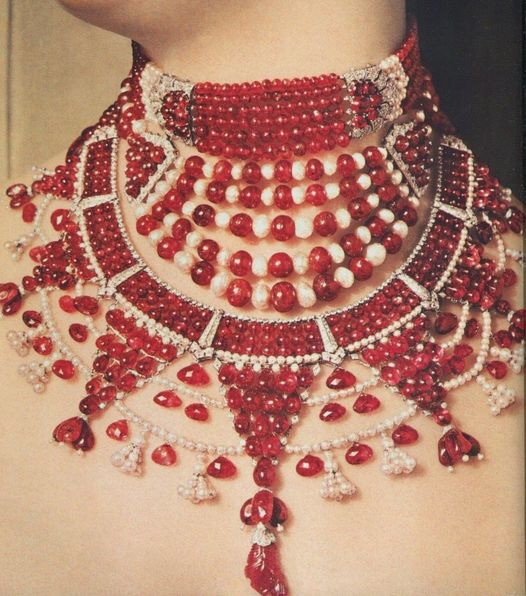
Ruby and pearl necklace by Cartier for Sir Bhupinder Singh, Maharaja of Patiala in 1928.
#ruby#pearl#necklace#cartier#sir bhupinder singh#patiala necklace#maharaja of patiala#1920s fashion#early 20th century#1920s art#jewelry#red#historical fashion#paleta post
56 notes
·
View notes
Text

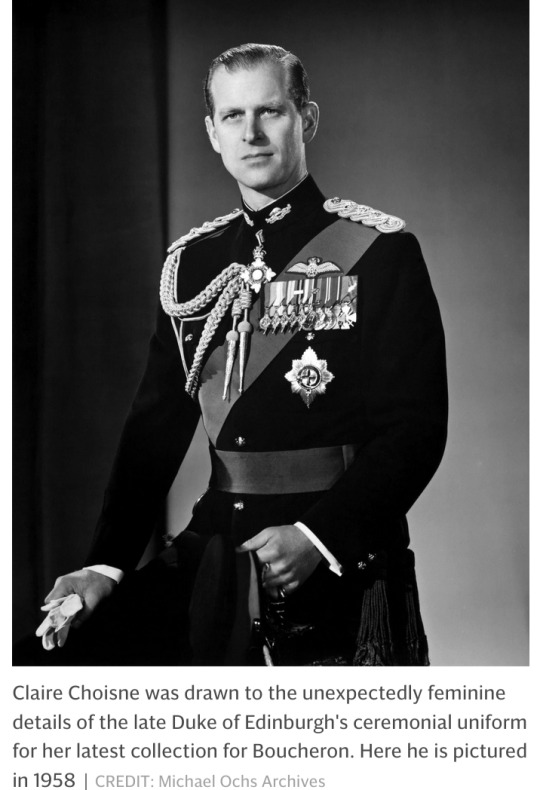
In her 13 years as creative director of the French jewellery house Boucheron, Claire Choisne’s mood boards have featured some unusual suspects.
This January, she introduced the latest high jewellery collection with a picture of Prince Philip waving at crowds during the coronation in 1953.
He’s decked out in his Admiral of the Fleet finery, decorated with military medals and orders of chivalry, white ribbons fluttering at his shoulders.
‘OK, Prince Philip is not my absolute muse – but I love this picture,’ says Choisne via video call from the Tucson Gem Show, where she is shopping for the stones that will feature in the house’s 2026 collections.
She was drawn to the unexpectedly feminine details of the late Duke of Edinburgh’s ceremonial uniform.
‘You feel the power and the strength, but at the same time, there are all these couture details: bows, ribbons, embroidery. It’s a paradox.’
She decided it was the perfect way to interpret the well-trodden high jewellery theme of ‘couture.’
‘I didn’t want to do something too girly or cheesy. I wanted to give strength to the pieces. When I saw this picture, I said to myself, “OK, now I know how to manage the creation of this collection.”’
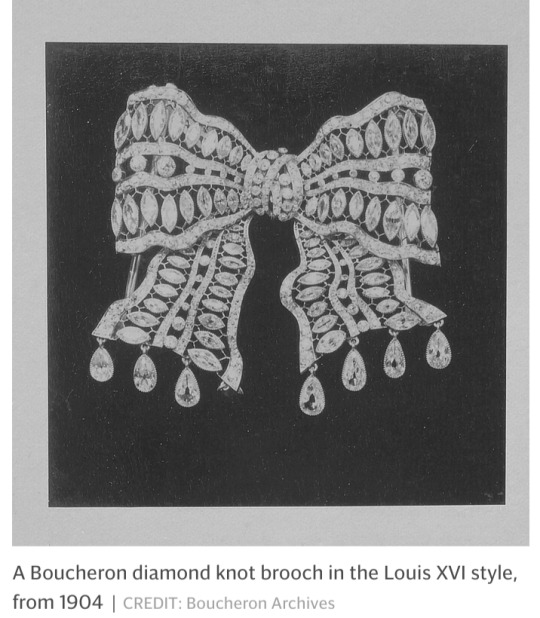
The resulting 24-piece collection, The Power of Couture, is the latest chapter in Boucheron’s annual Histoire de Style series, which sees Choisne reinterpret designs or themes from the house’s 166-year history.
Its founder, Frédéric Boucheron, was the son of a draper and so the archive teems with diamond-set bows, ribbons and lace, with gold worked into supple-as-silk scarves.
A lace-like shoulder adornment made circa 1880 was a Belle Epoque predecessor of today’s white gold and diamond epaulettes, whose overlapping loops were inspired by a tiara made in 1902 for the Princess of Wales, later Queen Mary, Prince Philip’s grandmother-in-law.
Clipped across the shoulders, they’re a precious take on the traditional tasselled gold epaulettes of naval uniforms.
They also transform into cuffs; such versatility is a hallmark of the collection.
A set of 15 medal brooches can be strung into a bib necklace of epic proportions.
A rock-crystal and diamond bow can fasten to the shoulder or chest, or be fashioned into a multi-wear necklace, while its central diamond can be plucked off to become a ring.
A braided aiguillette can be worn military-style across the chest, draped around the waist, or disassembled into brooches and a bracelet.

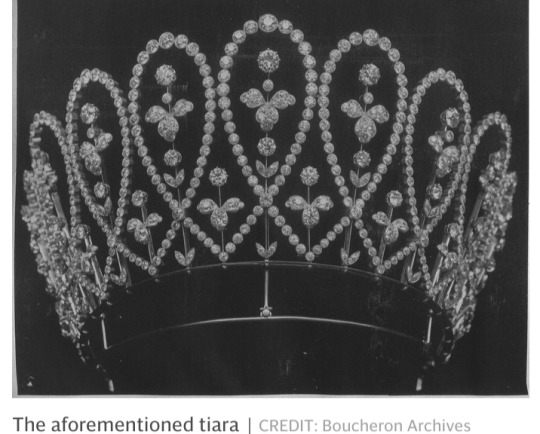
‘In ceremonial attire, there are so many rules that you have to respect. For the collection, I wanted the opposite,’ says Choisne.
‘I wanted people to be able to play freely and design their own style.’
She sees the collection as a ‘kit’ with an almost infinite number of styling combinations.
Her dream, she says, would be for one client to buy the lot. Whether that client is male or female is of little importance.
‘A long time ago, the people who wore high jewellery were men. The maharajas, the tsars, the kings. The biggest and most beautiful pieces were designed for men.’
One of Boucheron’s most famous clients was the Maharaja of Patiala who, in 1928, had his guards cart some 7,571 diamonds and 1,432 emeralds from The Ritz to the Boucheron boutique, to be set into 149 extraordinarily opulent jewels – a commission that inspired New Maharajas, the house’s 2022 Histoire de Style high jewellery collection.
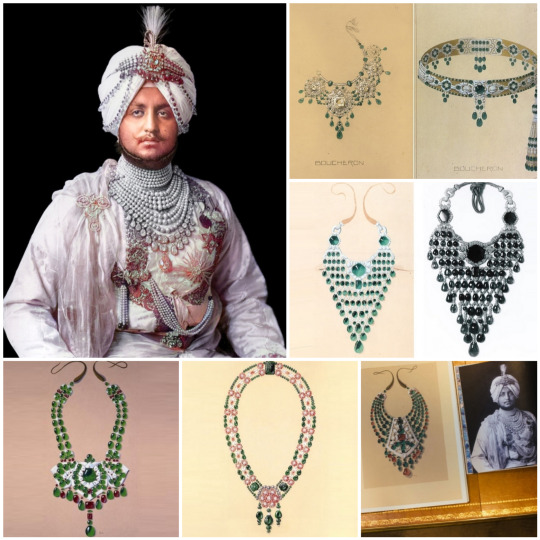
Sir Bhupinder Singh, Maharaja of Patiala, GCSI GCIE GCVO GBE (12 October 1891 – 23 March 1938)
'Today,' continues Choisne, 'I don’t want to do pieces for men or for women. I want to make beautiful and meaningful pieces. And I want to show that it’s beyond gender.’
She says that men do buy and wear Boucheron high jewellery, but she doesn’t know the precise proportion of male customers.
‘I almost don’t want to know exactly, because I’m sure of my idea. And maybe we have to show them that it’s a good one.’
Three years ago, Boucheron’s art deco-inspired Histoire de Style collection was photographed on male and female models – a first among Place Vendôme’s traditional maisons.
‘I knew that some of the pieces were even stronger on men. But the idea of it was almost weird at that time. People asked me, “Are you sure, high jewellery on men?” And my answer was, “Yes, definitely,”’ says Choisne.
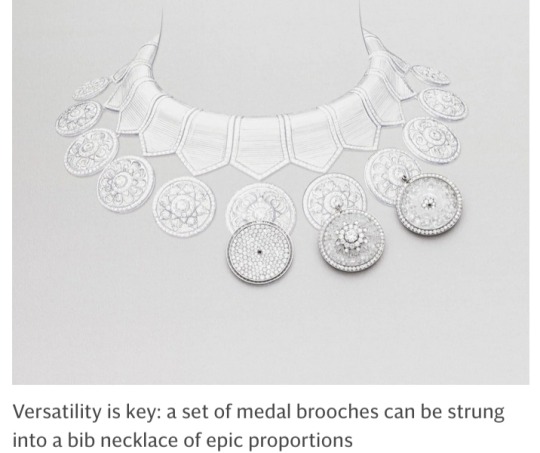
The Power of Couture collection, conversely, was exclusively photographed on and modelled by women; another deliberately defiant move.
‘When you think of ceremonial attire, you naturally think of men. So I wanted to show the opposite. It doesn’t make sense for me to choose between men and women. Nowadays we can do what we want.’
A pair of embroidery-inspired diamond ferns have an ethereal, Greek goddess-like beauty when worn as a headpiece.
But one can also imagine them pinned to a tuxedo, echoing the actor Regé-Jean Page, who wore a feather-shaped diamond Boucheron brooch at last year’s Oscars.
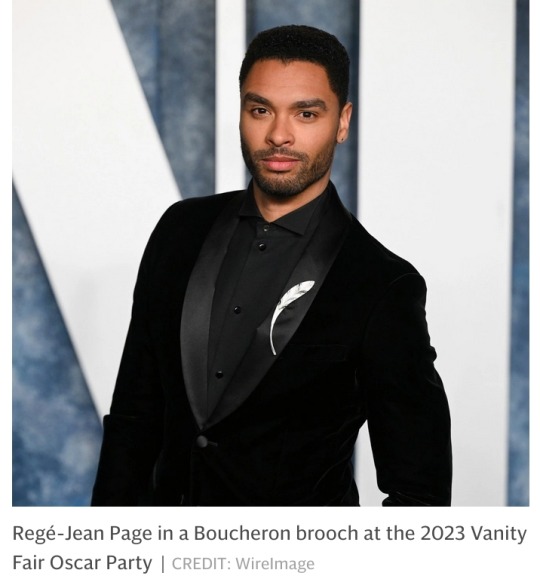
Although it may take a Liberace-channelling peacock to carry off a lacy diamond collar, even the most bling-averse gentleman could be tempted to affix a few rock crystal and diamond buttons to his dress shirt.
Choisne says Boucheron’s clients span the whole spectrum.
‘It’s the same for men as it is for women: some are more classical, and some are super edgy.’
Culture plays a role. ‘Maybe European men are a bit more traditional, whereas in Asia men can be more open-minded when it comes to style.’
It was important that the Power of Couture collection wasn’t too literal, says Choisne; it couldn’t feel like fancy dress.
A restrained, all-white palette of rock crystal and diamonds helps; she champions texture and detail over bold hues or glitzy brilliance.
The pieces are labelled with their carat weight along with the hours involved in their creation – many run into the thousands.
‘If you put a lot of little diamonds everywhere, it’s easy. It will shine, so you have no doubt that it’s precious,’ says Choisne.
‘But I prefer to find preciousness with purity of design and elegance, which come from the craftsmanship. It’s not about having lots of diamonds. The number of hours is what makes it high jewellery.’
The transformable Noeud bow, for example, is crafted from hundreds of individually cut lines of frosted rock crystal, threaded together through their diamond edging to evoke the texture and fluidity of grosgrain ribbon.
‘It would be much faster and easier to engrave a single piece, but I wanted it to be really flexible. So they cut every little line by hand. Each one is a different length. It’s crazy work to achieve that.’
That’s 2,600 hours of crazy work, to be precise.
Elsewhere, sandblasted rock crystal is knitted together into the flexible, five-strand Tricot choker.
’The idea was to give an illusion of knit work,’ says Choisne. ‘The unpolished rock crystal gives the feeling of softness, like wool.’
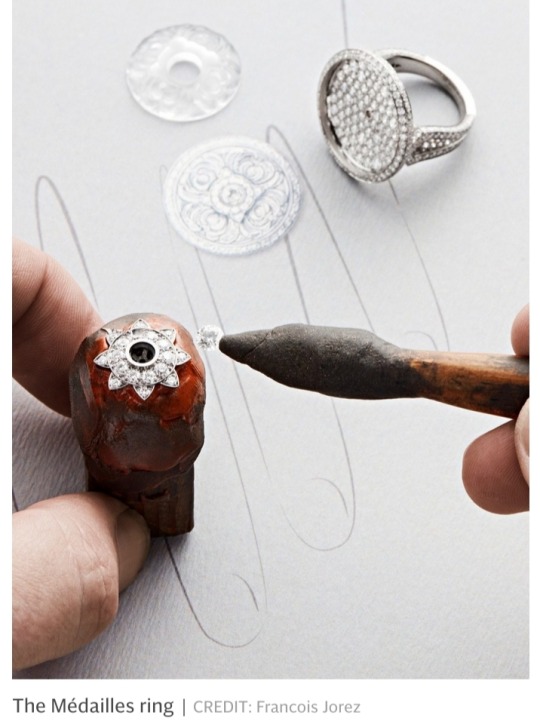
The Médailles feature grosgrain-effect rock-crystal ribbons, from which hang 15 medallions of sculpted rock crystal overlaid on to beds of brilliant-cut diamonds.
‘We cut the rock crystal with the glyptic technique – it’s much more complicated than engraving. Then we set diamonds underneath so they are a bit blurred. For me, it’s more magical.’
It’s clear that Boucheron’s craft workers relish Choisne’s technical challenges.
They are currently making the pieces that will launch in July 2025 (Boucheron presents two high jewellery collections a year), while Choisne is finalising designs for 2026 and developing her ideas for 2027.
It’s not always easy to sleep with so many different concepts buzzing around her brain, she admits.
Her approach to design mirrors the demands she asks of her atelier. ‘I don’t love it when it’s too easy.’

boucheron.com
#Prince Philip#Duke of Edinburgh#British Royal Family#Boucheron#Claire Choisne#jewellery house#fashion#Tucson Gem Show#Coronation 1953#fine jewe#fine jewellery#couture#The Power of Couture#Histoire de Style#Frédéric Boucheron#epaulettes#Maharaja of Patiala#glyptic technique#aiguillette#Queen Mary#Maharaja Sir Bhupinder Singh
9 notes
·
View notes
Text
also. so many actual heirlooms were looted from us. so many people were looted by the british. and like i'm sorry but lieutenant-general maharaja sir bhupinder singh, gcsi, gcie, gcvo, gbe, gcsg, owner of 44 rolls royces, master of a harem of 350 concubines, client of the largest cartier order of the time while everyone else was starving in a post-wwi economy, first indian to own a private plane, staunch supporter of the british raj and ally to the east india company in the first anglo-sikh war, was not "looted".
#diljit dosanjh#even if the british didn't exist even if we weren't colonized we STILL would not have access to these pieces#yknow why? because 'we' were working the farms.
0 notes
Photo

Diamonds have captured the imagination of royalty through the centuries. They continue to beguile and fascinate women across all ages. Sathya Saran traces the gem’s journey from Mughal courts to its modern interpretations as an aspirational heirloom.
Almost as mesmeric and perennial in their sparkle as the stars in the sky, these are stars that nature rafts deep within the earth. Working in her mysterious way to transform base matter into a diamond with the same precision with which she helps a caterpillar emerge as a butterfly.
But unlike the butterfly which lives for a brief day, the diamond never loses its brilliance. Making it a gem that the powerful loved, seeing as they did in its hardness a symbol of their own invincibility; and in its brightness a reflection of their power and light. Today, the diamond continues as a signifier of individual achievement.
Lighting up Mughal courts
Indian kings have always found a special place for diamonds. Sir Thomas Roe, Ambassador to the Mughal court, notes with wonder in his manuscript, titled “Embassy of Sir Thomas Roe to the court of the Great Mogul, 1615-1619 as narrated in his journal and correspondence” that Jahangir was “laden with diamonds”. Many museum exhibits dating back to as early as 1625, show diamonds shining from Indian turban ornaments, and decorating the jade handles of swords and daggers that belonged to Indian kings or nobles.
Abdul Hamid Lahori who witnessed the court of Shah Jahan, speaks of the diamonds that dominated the gem-encrusted Peacock Throne. Lahori’s account includes the 186-carat Koh-i-Noor diamond, the Akbar Shah diamond weighing 95 carats, as well as the 88.77-carat Shah diamond and the 83-carat Jahangir diamond. The only other gem he notes is the exceptionally large Timur Ruby, which at 352.50 carats was the third-largest Balas ruby in the world.
A dagger hilt set with a mythical lion-headed beast, possibly from Tanjore or Mysore, was bedecked mainly with Kundan set diamonds, alongside rubies and emeralds.
Favoured embellishment
The mines of Golconda yielded their beauty, and royal houses in Hyderabad had gold betel leaf boxes that were decorated with diamonds and enamelled panels, as well as diamond studded gold bowls with matching stands, which were possibly from the late 1700s. And of course, the diamonds in the Nizams’ family collections could have bought the rest of India!
Table cut and round Kundan diamonds, combined with Cabochon rubies and emeralds were used to decorate Tipu Sultan’s throne, and by the 1800s, diamonds were indispensable and embellished every royal object from ankush to anklets. And historians write about Lord Clive, who brought back from his sojourn in India, two impeccably cut pear-shaped diamonds presented to him by the Nawab of Arcot. The ‘Arcot diamonds’ were, in turn, presented by Clive to Queen Charlotte, who wore the 1,20,000 pound gift in her ears. By the 20th century, Indian kings were patronising European jewellers like Cartier, Van Cleef & Arpels and Harry Winston, influencing their creations with Indian motifs.
Modern marvels
Over the centuries, many treasures created by these houses for royalty have disappeared.
The story of the Patiala necklace that Cartier created for Bhupinder Singh of Patiala in 1911, with 2,930 diamonds that centred around the 234.65 carat De Beers diamond is well known. While the cause of the necklace’s disappearance in 1928 was never discovered, the pieces of it found by a Cartier associate in a second-hand jewellery store were bought by the group to help reconstruct the original with imitation stones.
Also, part of royal history is the large diamond buckle that Shatrujit ‘Tikka’ Singh of Kapurthala remembers seeing, in photographs of his grandfather, at public receptions. According to him, “Mahajal, one of the world’s top ten diamonds was a cushion cut yellow diamond of 139.38 carats, procured in the 1730s when Nadir Shah was sacking Delhi and we were sacking him. It disappeared during the confusion of the Partition. Never to be seen afterwards. The story is it was cut into smaller shapes to suit changing tastes”.
Every royal family has a diamond story. Nawab Kazim Ali Khan of Rampur while remembering a tiara and a crown of incomparable diamonds, says: “Though our family was partial to Basra pearls and had baskets full of them”.
The aspiration to own and wear diamonds today continues to dwell in most Indian hearts, as much due to its romantic association with royalty and the past, as the stone’s own allure.
2 notes
·
View notes
Text
The most wonderful valuable gems claimed by Indian regal families
A decent couple of years prior, the Indian subcontinent was known to be the money box of the world. The mineral-rich terrains that yielded the best of stones pulled in many achieved architects and craftspeople. Indian imperial families have been illustriously parading their monstrous abundance through their stunning strongholds, castles and gems. From Kashmiri Sapphires to Golconda jewels, the Indian royals have seen and claimed everything. Gems have for some time been a necessary piece of India's customary and stylish personality, all the more thus, among the leaders of the land. Here's taking a gander at a portion of the unbelievably flawless gems claimed by the imperial groups of India. To know more click here best jewellery in Hyderabad.

Patiala ruby choker - Maharani of Patiala
Made via Cartier Paris in the year 1931, this Patiala ruby choker was a great choker jewelry made in platinum. Rubies, pearls and precious stones were utilized to make this incredible piece of gem. Simply the upper piece of the jewelry comprised of six layers of rubies with precious stones as well as pearls on the sides. The middle piece of the neckband contains rubies with pearls while the lowermost piece of the accessory was the heaviest of all with pearls and precious stones. To know more click here best jewellery in Tamil Nadu.
Precious stone crown - Maharaja of Kapurthala
Wearing a lovely precious stone crown and a 12-string Basra pearl jewelry alongside a bejeweled precious stone belt, the Maharaja of Kapurthala generally had a liking for terrific gems. The Maharaja is seen wearing a customary sherwani with gold brocade weaving with his regular band and the Star of India clasp, an honor gave to choose Indian rulers by the British Crown. By simply investigating this picture, you can perceive how the Maharaja had a reasonable preference for his regal gems and a sharp eye for style, plan as well as show. To know more click here best jewellery in Andhra Pradesh.
Star of the South precious stone accessory - Maharani Sita Devi of Baroda
A 3-layered precious stone neckband comprising of a noteworthy 128 carat Star of the South jewel was worn by Maharani Sita Devi of Baroda. It likewise had a 78.5 carat English Dresden precious stone in it. The Mulhar Rao, the Gaekwar of Baroda purchased the Star of South for £80,000, or around 20 million INR. Later on, this piece of adornment was purchased by Rustomjee Jamsetjee of Mumbai and offered to Cartier in 2002. To know more click here royal Indian jewellery in Hyderabad.
Kundan haar - Maharaja Prabhu Narayan Singh of Banares
Maharaja Prabhu Narayan Singh of Benares used to take his legal gems out for intermittent circulating. In this photo, the Maharaja is seen wearing a stunning Kundan jewel haar made for certain other valuable gemstones. He is seen wearing the average sarpech with an appended feather tuft. He likewise wears numerous other complex articles of gems that incorporate chime and polki precious stone shoulder braces, bazubandhs, a bejeweled sword, a bejeweled belt, wristbands as well as rings. These are seen on a stately court outfit alongside the Star of India ornament.
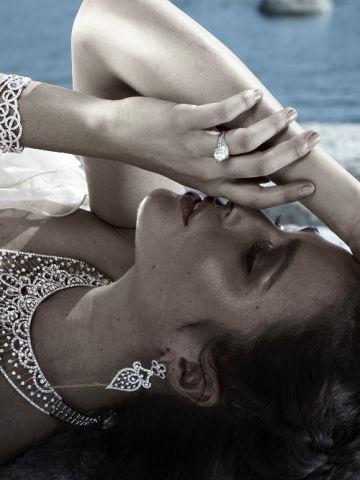
Patiala accessory - Maharaja Bhupinder Singh of Patiala
This exceptional regal neckband comprised of a sum of 2,930 jewels. It had the world's seventh biggest precious stone, a 234-carat yellow 'De Beers' as its focal point. This shocking piece was additionally made via Cartier Paris in the year 1928 for Maharaja Bhupinder Singh of Patiala. The astounding piece of adornment contained precious stones, topazes, manufactured rubies, citrine, platinum, zirconia, smoky quartz and Burmese rubies. To know more click here royal Indian jewellery in Tamil Nadu.
Jewel dastar - Maharaja Shrimant Sir Ranjit Singhji Sahib Bahadur of Ratlam
Taking a gander at the wedding photo of the grandson of Sayajirao III Gaekwad of Baroda, you can perceive he is wearing a remarkable turban shrouded in a cross section of multifaceted sarpattis made of jewels, pearls and a few other valuable gemstones. Maharaja Shrimant Sir Ranjit Singhji Sahib Bahadur of Ratlam is likewise seen wearing a Kundan haar made of jewels, pearls and gemstones, a pearl choker as well as hoops. Assuming you notice, you'll see even the angarkha that the Maharaja is wearing is shrouded in an enriching example of gold strings and sequins. To know more click here royal Indian jewellery in Andhra Pradesh.
Precious stone serpech - Maharaja Duleep Sing of Lahore
Maharaja Duleep Singh of Lahore, the last Maharaja of the Sikh domain is seen wearing a superb precious stone serpech. Fundamentally an embellishment is made for the turban. The three crests are completely made of jewels with a stunning emerald set solidly in the middle. By simply taking a gander at this representation of the Maharaja, you can perceive that he had perfect desire for gems going from hoops to layered neckpieces and bazubandhs. To know more click here bridal jewellery online shopping.
To inquire click here handmade jewellery.
To know more click here gold jewellery online.
To know more click here best online jewellery shopping store.
#best jewellery in Hyderabad#best jewellery in Tamil Nadu#best jewellery in Andhra Pradesh#royal Indian jewellery in Hyderabad#royal Indian jewellery in Tamil Nadu#royal Indian jewellery in Andhra Pradesh#handmade jewellery#gold jewellery online#best online jewellery shopping store#bridal jewellery online shopping
0 notes
Text
Evolution Of Platinum Bridal Jewellery

Platinum is thirty times more valuable than gold! This makes platinum jewellery a one-of-a-kind option for brides who want to make a statement at their wedding. Platinum is colourless, thus it has no effect on the colour of precious stones such as diamonds, emeralds, or rubies. Platinum is forty percent denser and easier to mould than other precious metals. These characteristics aid in the creation of a secure setting for precious jewels. Platinum jewellery is extremely long-lasting and resistant to tarnishing. These practical features make it an excellent investment in bridal jewellery that will last a lifetime. Get the help of the experts of Wedding Planner In Kolkata to find you the perfect place to buy the special ornament!
Platinum in the past The use of platinum in the creation of royal and grand jewellery dates back to the eighteenth century French royal court. The French Emperor Louis XV declared platinum to be the only metal suited for a monarch in 1751. Fast forward to the art deco era of the 1930s, when platinum became the metal of choice for Europe's upper crust. This comprised coronation tiaras, bridal jewellery, and the world's glitterati's signature items. The legendary Patiala Necklace was the peak of platinum brightness. The Patiala Necklace, one of the most valuable pieces of jewellery ever made, was crafted for Maharaja Sir Bhupinder Singh of Patiala in 1928. The necklace is renowned for its unrivalled brilliance and unique design. Five rows of huge solitaire diamonds are set on platinum chains in this piece.
Platinum in the present Platinum jewellery is beautiful in today's world and has a universal aesthetic appeal. This is why, on the wedding day, more ladies are opting for platinum jewellery. The density of platinum allows for very little metal in the settings, almost to the point of invisibility. The stones utilised in the jewellery become more noticeable as a result of this. As a result, this metal is suitable for diamond bridal jewellery. Modern platinum bridal jewellery is intricately designed and has a delicate filigree style appearance. This is due to platinum's ability to tolerate high amounts of stress, allowing for finer jewellery. While looking for the event management companies near me, you can also search for the top platinum jewellery stores who have the trendiest designs.
Platinum in the future In recent years, India's platinum imports have steadily climbed. This is a strong signal that demand for this precious metal is increasing, and we can expect to see more fascinating platinum jewellery designs in the future. Brides may also consider having at least one platinum set in their bridal trousseau, as platinum is expected to remain popular among modern women. This will be a favourite for events such as wedding receptions where the bride's outfit isn't constrained by tradition.
Platinum jewelry's complex beauty will always attract onlookers. Platinum is the ideal choice for creating magnificent jewellery sets, especially when combined with diamonds. Brides should expect greater innovation in platinum jewellery design in the future.
0 notes
Text
Cricketers Who Played Test Cricket for India.
The game of cricket in India was beginning around the 18th century and gradually spread throughout India during British rule.
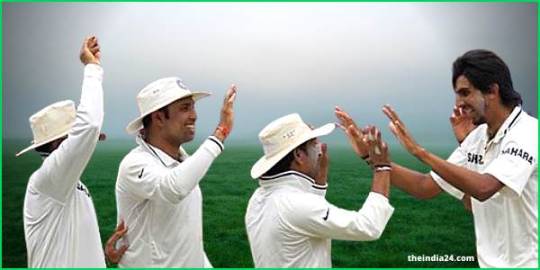
Kumar Shri Ranjit Singh Ji is one of the legends of Indian Test cricketers from the very beginning of cricket in India, whose aggressive batting often forces the opponent team to battered.
He was the first Indian player who played Test cricket for a foreign country, He played 15 Tests for the England cricket team against Australia between 1896 and 1902 but never played a Test match for India.
India's most prestigious domestic first-class cricket tournament, the Ranji Trophy, has been named after him.
The Indian cricket team was played their debut Test match on 25 June 1932 at Lord's, England, that was a three-day Test match.
Playing their debut Test match at Lord's, India became the sixth country in the world who have the status of Test-playing nations at that time.
But after twenty years later, India got their first Test match win in the fifth Test match which was played at Madras Cricket Club Ground, Chepauk, Madras during England's tour of India from 6 February to 10 February.
And since then, many Indian Test Cricketers have made their valuable contribution from time to time in Indian Test cricket, whose brief description is given here.
List of Indian cricketers and their performance stats:

Some interesting facts about Indian cricket:
Official first-class cricket in India was debut in 1864 under British rule, this match was played between Madras Club and Calcutta Club which were organized by the British government.
One of the most significant persons in the miraculous history of Indian cricket was the Maharaja of Patiala Sir Bhupinder Singh 'Bhuppi' who will be always be remembered for his contribution to Indian cricket.
He was a great patron of the cricket game. He promoted the game of cricket by spent his own money and organized various cricket tournaments in India as well as sponsoring various foreign tours of India as there was no cricket control board in India at that time period.
His cricket team Patiala XI was one of the best in India, which was the official team of Patiala till 1947 and participated in the Ranji Trophy.
He played 27 first-class cricket matches between the span of 1915 to 1937 in which he scored a total of 643 runs at an average of 17.37 and the highest score was 83, besides this, he also took two wickets for 60 runs.
He also played for the Marylebone Cricket Club in London and was the captain of the Indian cricket team that first toured to England in the year1911.
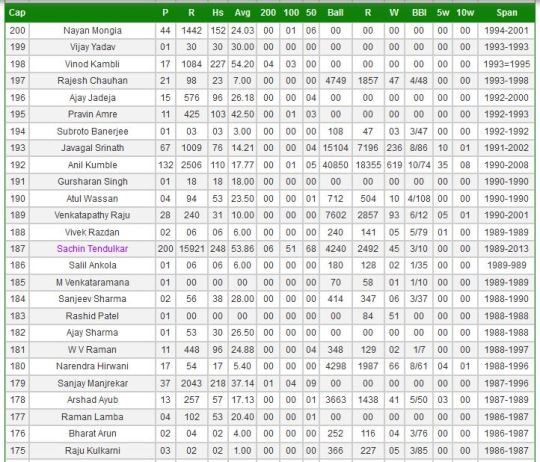
Debut Test Match of Indian Test Cricketers:
Indian Test cricketers played their debut Test match at Lord's on 25 June 1932. In this Test batting first after winning the toss, England scored 259 runs in their first innings, in which captain Douglas Jardine formed, a personal contribution of the highest 79 runs in the innings.
In these innings, Indian bowler Mohammad Nissar had dismissed England's five-wicket by giving just 93 runs.
India scored a total of 189 in their first innings, in which team skipper C.K.Nayudu formed up the personal contribution of the top 40 runs in the innings.
In these innings, England bowler Bill Bowes dismissed four wickets for 49 runs and Bill Voce took three wickets of India by the expenditure of just 23 runs.
In England's second innings, the innings was declared by uploading the 275 runs on the scoreboard for the loss of 8 wickets in his second innings, in which skipper Douglas Jardine formed a personal contribution of the highest 85 runs while remaining unbeaten in the innings.
In these innings, Indian bowler Jahangir Khan has dismissed four wickets for 60 runs and Amar Singh took two wickets of England by the expenditure of 84 runs.
In this way, England has all set a little bit difficult target for India to score 346 runs in their second innings to win this test match. Kindly click here to continue reading the article...
0 notes
Photo

Always Great to be Dr. Bhupinder Singh Saggu sir CEO APAC of #Blockchain of 4th Generation #HYDRUS7 #JDCoin #JDC to created wealth in #Crypto & #Blockchain industry with marvelous features of #Staking #MasterNode #DApp #DeFi #Gamings #SmartContracts & #Token development with Super Ultra #TPS with lowest fees forever for #Cryptocurrency industry... For best investment offers in #Crypto #AskToRahulSingh #CryptoAnalyst #BlockchainExpert #AskMeHow +91 836 841 3867 (WhatsApp Global) (at Ghaziabad,delhi NCR) https://www.instagram.com/p/CJdBULqrplR/?igshid=xf1vr8cz7paj
#blockchain#hydrus7#jdcoin#jdc#crypto#staking#masternode#dapp#defi#gamings#smartcontracts#token#tps#cryptocurrency#asktorahulsingh#cryptoanalyst#blockchainexpert#askmehow
0 notes
Text
Indian Royal Families And Their Controversies That're Kept Secret Until Now
Indian Royal Families And Their Controversies That’re Kept Secret Until Now
When the personal life of a celebrity is at stake, all of us may feign disinterest, but secretly love the scandal. But if the celebrity has a royal connection, you may be forgiven to disregard propriety and obligation to show respect.
But alas, we have been deprived of so many Indian royal secrets and scandals, either by brilliant PR professionals or by being at a rarely read page in the…
View On WordPress
0 notes
Text
Boucheron thương hiệu trang sức Pháp được thành lập bởi Frederic Boucheron vào năm 1858, với việc khai trương cửa hàng đầu tiên tại Galerie de Valois, Palais-Royal vào thời hoàng kim của đế chế Pháp thứ hai. Ông đã xây dựng nhà xưởng vào năm 1866 và một năm sau đó giành được huy chương vàng trong triển lãm Universelle (1867).
Frédéric Boucheron
Ông đã thiết kế ra các món đồ trang sức tinh tế, mang vẻ đẹp bí ẩn và thu hút bởi sự xa hoa của nó. Những thiết kế trang sức của ông lấy cảm hứng hoạ tiết từ thiên nhiên như trang sức hình con rắn – biểu tượng của tình yêu và sự bảo vệ.
snake necklace
This slideshow requires JavaScript.
Năm 1893, Frédéric Boucheron đã trở thành nhà kim hoàn đầu tiên chuyển tới Place Vendôme. Truyền thuyết kể rằng ông đã chọn số 26 Place Vendôme, vẫn còn của hiệu Boucheron cho đến ngày nay, bởi vì là góc nắng nhất khu quảng trường. Ông tin rằng ánh nắng sẽ làm những viên kim cương trong cửa kính sẽ chiếu lấp lánh và rực rỡ hơn.
Năm 1893, Boucheron đã mở một cửa hàng tại Moscow, sau đó chuyển đến Saint Petersburg vào năm 1911. Năm 1903, một cửa hàng ở London và một văn phòng tại New York, một cửa hàng tại Nhật Bản vào năm 1973, Thượng Hải, Dubai vào năm 2005, và cuối cùng là Hồng Kông và Kuala Lumpur vào năm 2006.
Bộ sưu tập thiết kế trang sức ấn tượng đầu tiên của Boucheron đã được trình diễn bởi người đẹp nổi tiếng Caroline Otero
Năm 1878, Hoàng tử nước Nga Felix Youssoupoff trong một lần đến Paris đã mua một chiếc nơ cài áo kim cương được thiết kế & chế tác bởi Boucheron.
Năm 1921, Boucheron được giao nhiệm vụ chế tác một vương miện cho Lady Greville mà sau này trở thành Hoàng Thái Hậu Elizabeth Anh Quốc. Cháu trai bà là Hoàng tử Charles đã trao vương miện này cho vợ mình là Camilla. Nữ hoàng Elizabeth II cũng có một bộ sưu tập đồ trang sức Boucheron.
Trong năm 1928, ông Hoàng Ấn Độ Maharaja of Patiala đã được đưa đến cửa hàng Boucheron ở Place Vendôme để bổ sung đá quý cho kho báu của mình.
Ngoài , người bảo trợ của hoàng gia của Boucheron được rất nhiều hoàng gia yêu thích như Nga Hoàng Czar Alexander III, Maharajah Sir Bhupinder Singh of Patiala, Riza Shah Pahlevi, Queen Farida của Ai Cập và Hoàng hậu Rania của Jordan.
Boucheron ‘Wave Tiara’
Boucheron đã biên soạn một hệ thống phân loại theo đó để xác định giá trị của một viên kim cương, được phát triển trên cơ sở tiền tệ quốc tế của kim cương. Phương pháp Boucheron của sự đánh giá cao đã được đăng ký dưới tên B.I.R.D (Boucheron International Rating of Diamonds). Hệ thống phân loại ban đầu này được dựa trên một đánh giá về chất lượng kim cương và dựa trên một phân tích kết hợp của hai tiêu chí: thứ nhất, độ tinh khiết (clarity) và thứ hai, màu sắc (colour) của viên kim cương. Dựa trên hai tiêu chí này để phân loại chất lượng kim cương từ 90/100 đến 99/100. Đạt 100/100 là viên kim cương hoàn hảo, theo tiêu chí của Boucheron.
Boucheron là một doanh nghiệp gia đình: sau khi người sáng lập Frédéric Boucheron mất vào năm 1902, hậu duệ của ông đã tiếp quản công việc kinh doanh. Trong năm 1994, Boucheron được bán cho Schweizerhall để có thể mở rộng thị trường ra toàn cầu. Boucheron sau đó đã được sát nhập vào Gucci Group năm 2000, tiếp theo được mua lại bởi tập đoàn Kering (trước đây là PPR) vào năm 2004.
Nguồn: Boucheron với tất cả sự ngưỡng mộ của chúng tôi
Boucheron: Trang sức của ánh sáng lung linh toả sáng Kinh đô Paris Boucheron thương hiệu trang sức Pháp được thành lập bởi Frederic Boucheron vào năm 1858, với việc khai trương cửa hàng đầu tiên tại Galerie de Valois, Palais-Royal vào thời hoàng kim của đế chế Pháp thứ hai.
2 notes
·
View notes
Photo

Birth Anniversary..! Maharaja Sir Bhupinder Singh..! 12 October 1891..! #MaharajaSirBhupinderSingh was the ruling Maharaja of the princely state of #Patiala from 1900 to 1938..! https://www.instagram.com/p/Bo1RRYGAw5L-52s44I27j6s9GXgdNLZHSlk_Jg0/?utm_source=ig_tumblr_share&igshid=gk8kmluven7k
0 notes
Photo

New Post has been published on http://www.visionmp.com/behind-pm-modis-move-unveil-64-feet-statue-haryanas-angry-jat-population-eye-2019/
Behind PM Modi's Move to Unveil 64-feet Statue is Haryana's Angry Jat Population and an Eye on 2019
Rohtak: The BJP is going all out to woo the Jat vote bank in Haryana ahead of the upcoming Lok Sabha and assembly elections. What underlines BJP’s hurriedness is the fact that Prime Minister Narendra Modi will on Tuesday unveil the statue of peasant leader Sir Chhotu Ram at Garhi Sampla in Rohtak.
The event assumes even more significance as PM Modi is visiting Jat land much earlier than scheduled. He was earlier supposed to attend a BJP rally in Karnal on November 1 to mark the completion of four years of Manohar Lal Khattar government in the state.
However, the BJP was forced to advance his visit to October 9, owing to the pressure built by opposition party Indian National Lok Dal (INLD), which had been demanding immediate unveiling of the statue as it has been ready for about 9 months now.
Chief Minister Khattar, however, said the delay in unveiling of the statue was not an issue. “But since elections to three big states are due in November, PM Modi couldn’t have spared time later. So, he will be coming on October 9. We will be happy if he still makes it on November 1. However, our national president Amit Shah has assured that he will be present then,” he said.
The BJP and INLD have locked horns over the unveiling of Sir Chhotu Ram’s statue in his paternal village as they try to cash-in on the political legacy of the peasant and Jat leader.
And for the BJP, it would be even more crucial as support from Jats, who comprise one-fourth of the population, has eroded over the last four years.
The erosion can be traced to the appointment of Khattar, the first non-Jat chief minister of the state, the inept handling of the Jat agitation by the state government and anti-Jat statements made by some party leaders, thereby worsening the situation.
But not just the BJP, all major political parties have tried their best to appropriate Sir Chhotu Ram’s legacy and ever since Haryana was carved out of erstwhile Punjab on November 1, 1966, not a single election has passed in which his name hasn’t been mentioned.
Union steel minister Chaudhary Birender Singh, the maternal grandson of Sir Chhotu Ram and has been invoking him every year on the occasion of Vasant Panchmi.
The former Congress veteran, who had switched to BJP during the last Lok Sabha polls, was the first to get constructed a memorial in his name in 2004.
Singh’s bête noire and INLD supremo Om Prakash Chautala had in 2005 organsied a huge rally in Garhi Sampla and had also dedicated a one-room museum which housed books, clothes and other items used by the peasant leader.
The real battle over his legacy kicked off in 2016 when Singh, calming to be his political heir, announced that a tall statue of his would be installed in Garhi Sampla and Prime Minister Narendra Modi will himself come to unveil the statue.
Subsequently, a 64-feet-tall iron statue was erected but the inauguration has been hanging fire for the past nine months. Meanwhile, the earlier, smaller statue, which was erected by OP Chautala was shifted to a government college in Sampla, drawing the ire of the INLD.
While it remains Singh’s dream project, the BJP has tried to woo the Jat vote bank from day one. The BJP h as already rechristened Garhi Sampla village as Sir Chhotu Ram Nagar.
State finance minister Capt. Abhimanyu, when questioned over the issue denied having any political motive behind the unveiling of the statue, without forgetting to mention what his party had done in the name of Sir Chhotu Ram.
“Deenbandhu Chaudhary Sir Chhotu Ram was never associated with a particular caste. He was a messiah of the farmers, the poor. He was above politics, caste and religion. Similarly, the BJP doesn’t believe in the politics of caste. PM Modi’s message is clear. BJP is a party dedicated to the farmers,” he said.
“Even Former Prime Minister Atal Bihari Vajpayee had attended a state-level Deenbandhu Prerna rally of the BJP back in 2005. We started the Deenbandhu Gram Uday Yojna in the first year of our government and had allocated Rs 1200 crore then,” he added.
The Jat leader from Rohtak also lambasted the opposition parties for ‘deriding’ Sir Chhotu Ram. “INLD has always seen every issue through a prism of caste and it reflects its narrow-mindedness. History speaks for itself. Sir Chhotu Ram was ill-treated by the Congress and he had to leave the party and form his own ‘Unionist (Zamindara)’ outfit. The forefathers of the INLD also had maltreated the peasant leader. In such a scenario I don’t expect much from the INLD and the Congress,” he said.
The INLD, however, maintained that the BJP was trying to poach its traditional vote bank. Party leader RS Chaudhary said the party had been demanding for over a year that the statue be inaugurated.
“Our youth leaders took up the matter and went among the masses. It was only then that they assured to unveil the statue on November 1. The BJP and the Congress are in a habit of shedding crocodile tears. If BJP is claiming to be a party of the farmers, why the Swaminathan report hasn’t been implemented. It is all political gimmick as the elections are approaching,” he said.
Even as the BJP and the INLD slug it out, the Congress has adopted the policy of wait and watch. It is treading the path carefully as its share of the Jat vote bank remains consolidated. Former chief minister Bhupinder Singh Hooda, himself a tall Jat leader and seemingly unfazed, said, “Narendra Modi is the Prime Minister of this country and he can go anywhere he wants. Though it is my assembly constituency, but still if the PM is visiting, he should be announcing at least something for the people here”.
In the 2014 assembly elections, the Jat voters, had remained loyal to their traditional parties – INLD and the Congress. Hooda had won 10 of the 14 seats in the Deswali Jat belt (Jhajjar, Rohtak, Sonepat, Bahadurgarh, Badli) while the INLD had won all the five seats in Sirsa.
The BJP had come to power for the first time in the state in 2014 by winning majority of the seats falling on the GT Road belt. Out of the 25-odd seats in this region, the BJP had won 22 taking its tally to 47. Five districts- Ambala, Karnal, Kurukshetra, Yamunanagar and Panchkula districts — fall on the GT Road belt.
0 notes